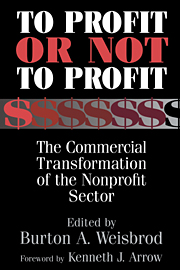Book contents
- Frontmatter
- Contents
- List of contributors
- Foreword by Kenneth J. Arrow
- Preface
- 1 The nonprofit mission and its financing: Growing links between nonprofits and the rest of the economy
- Part I Basic issues and perspective
- 2 Competition, commercialization, and the evolution of nonprofit organizational structures
- 3 Modeling the nonprofit organization as a multiproduct firm: A framework for choice
- 4 Pricing and rationing by nonprofit organizations with distributional objectives
- 5 Differential taxation of nonprofits and the commercialization of nonprofit revenues
- 6 Interdependence of commercial and donative revenues
- 7 Conversion from nonprofit to for-profit legal status: Why does it happen and should anyone care?
- Part II Industry studies
- Part III Overview, conclusions, and public-policy issues
- Appendix: IRS Forms 990 and 990-T for nonprofit organizations
- References
- Index
4 - Pricing and rationing by nonprofit organizations with distributional objectives
Published online by Cambridge University Press: 30 November 2009
- Frontmatter
- Contents
- List of contributors
- Foreword by Kenneth J. Arrow
- Preface
- 1 The nonprofit mission and its financing: Growing links between nonprofits and the rest of the economy
- Part I Basic issues and perspective
- 2 Competition, commercialization, and the evolution of nonprofit organizational structures
- 3 Modeling the nonprofit organization as a multiproduct firm: A framework for choice
- 4 Pricing and rationing by nonprofit organizations with distributional objectives
- 5 Differential taxation of nonprofits and the commercialization of nonprofit revenues
- 6 Interdependence of commercial and donative revenues
- 7 Conversion from nonprofit to for-profit legal status: Why does it happen and should anyone care?
- Part II Industry studies
- Part III Overview, conclusions, and public-policy issues
- Appendix: IRS Forms 990 and 990-T for nonprofit organizations
- References
- Index
Summary
Introduction
The growing commercial activity of nonprofit charities, hospitals, educational institutions, arts organizations, day-care centers, nursing homes, and religious organizations has led many to question the legitimacy of the nonprofit designation and the concomitant tax and regulatory advantages conferred upon the sector. As noted in Chapter 1, if nonprofit organizations are engaging in commercial activity, it is easy to regard them as simply “for-profits in disguise” (Weisbrod 1988); however, there are many varieties of commercial activity. This chapter focuses on the ways in which nonprofit organizations and private firms can be expected to differ in their use of various pricing and other mechanisms through which their goods and services are distributed. We emphasize the potential importance of distributional goals to nonprofits – that is, their concern about reaching certain target populations – and suggest that insofar as they have distributional concerns they will use allocation mechanisms (pricing practices, waiting lists, and the like) differently and have different effects on clients and others, compared with private firms.
Economists and other social scientists have looked at many aspects of nonprofit organization behavior, but we are unaware of any research that has examined the array of alternative allocation mechanisms employed by nonprofits, let alone their relationships to organization missions. Thus, our most important purpose is to provoke researchers, practitioners, and other readers to look across industry boundaries and particular allocation methods to refine understanding of the distribution of goods and services by nonprofit organizations – not only what nonprofits do, but for whom they do it.
- Type
- Chapter
- Information
- To Profit or Not to ProfitThe Commercial Transformation of the Nonprofit Sector, pp. 65 - 82Publisher: Cambridge University PressPrint publication year: 1998
- 12
- Cited by



